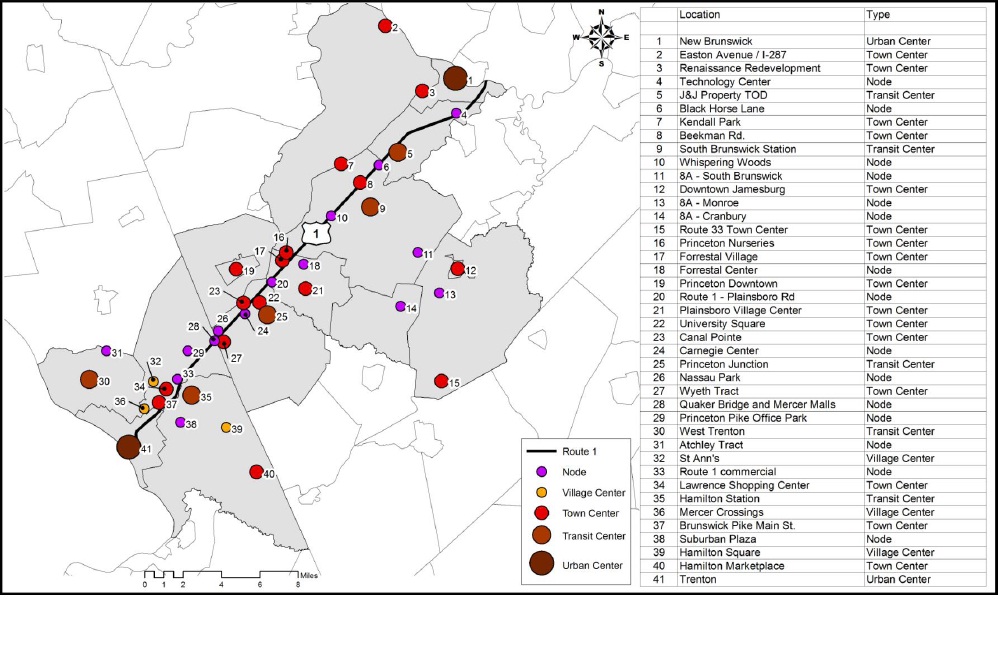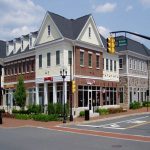New Jersey Future Blog
Traffic Isn’t The Only Type of Gridlock Along Route 1
September 16th, 2010 by Jay Corbalis
- According to the state Department of Transportation’s Route 1 Regional Growth Strategy, if everything allowed under current zoning along the Route 1 corridor between Trenton and New Brunswick were built, the result would be 480,000 new jobs — but only 37,000 new housing units.
- Under this scenario, the Growth Strategy predicts the percentage of roads in the region experiencing peak-hour congestion would increase from 13 percent today to 93 percent in 2025, essentially ensuring gridlock.
- The DOT’s Route 1 Regional Growth Strategy, developed after six years of study, recommends a future growth scenario in which development in the region is concentrated around 40 potential mixed-use, transit-accessible centers and nodes.
DOT Strategy Offers Vision for Future Growth in Region
Last spring, the New Jersey Department of Transportation released a draft of its long-awaited Regional Growth Strategy for the Route 1 region in Central Jersey. The report, produced with the help of several consultants, is the result of dozens of “stakeholder” meetings and workshops with local officials and other parties, as well as detailed projections about future growth and traffic patterns. Recognizing that continuing the status quo of low-density, automobile-dependent development will lead to diminished open space and severe congestion in most of the region, the strategy establishes a vision for future development featuring mixed-use centers served by an extensive transit network, anchored by a new, region-wide Bus Rapid Transit system linking major destinations.
This is precisely what New Jersey Future and other smart-growth oriented groups have advocated in the region for decades. And, encouragingly, there is broad buy-in among local officials about the need to address future land-use patterns on a regional basis. These officials recognize that zoning decisions in Plainsboro affect traffic in West Windsor, which affects property values in Princeton. For that reason, nearly all the major stakeholders in the region have been attending meetings of the Central Jersey Transportation Forum, a group assembled by the Delaware Valley Regional Planning Commission to deal with transportation and other issues at a regional level, for nearly 10 years.
Yet while virtually everyone agrees broadly on what is needed in the region, things quickly break down after that. Local officials might agree with the idea of higher-density “nodes” in theory, but defending an increased-density rezoning at a heated public hearing in their town is a different matter. Likewise, the Growth Strategy calls for new transportation investments in the region, including the BRT system, but the DOT is in no position to commit to paying for them at the moment.
Beyond these immediate concerns, there are larger, structural issues that impede the implementation of the plan. Because transportation investments and large, mixed-use developments of the type envisioned by the Growth Strategy are mutually dependent, each side faces a chicken-and-egg dilemma. No town wants to go out on a limb and rezone for higher density without some assurance that the transportation investments necessary to serve that development will be there — an assurance the DOT is neither willing nor able to provide at the moment. Likewise, the DOT is loath to invest millions of dollars in a transportation upgrade without assurances that it won’t be overrun with traffic from low-density sprawl, or, in the case of a BRT, under-used because of incompatible local zoning.
Given the fragmented nature of municipal government in New Jersey, what is needed here is an incremental, bilateral approach, coordinated by the DOT, whereby agreements are made with municipalities that condition state transportation investments on zoning changes and other local actions, in return for a commitment by the DOT to make such investments provided the zoning is in place. The DOT has already taken steps in this direction, withholding support for a local road improvement until West Windsor adopted a redevelopment plan for that area. More of this is needed. In the meantime, efforts like the Central Jersey Transportation Forum present unique venues for regional discussions that can advance this approach.

















